MiG-21MF Interceptor
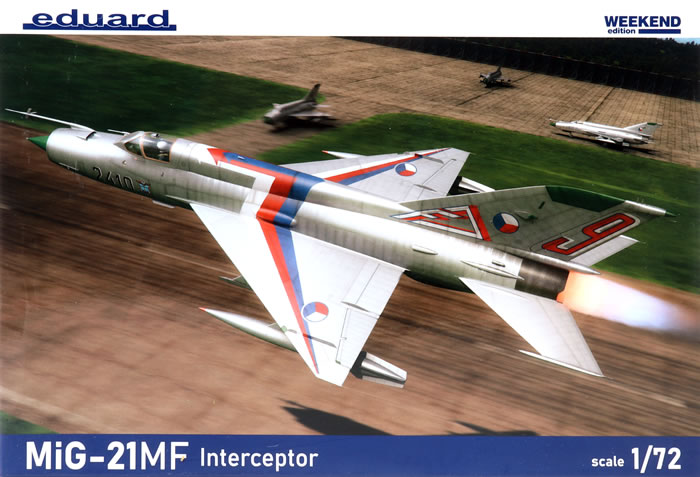
Weekend Edition, 1/72 scale
| S u m m a r y : |
Catalogue Number: |
Eduard Kit No. 7469 - MiG-21MF Interceptor Weekend Edition
|
Scale |
1/72 |
Contents and Media |
184 dark grey plastic parts; 13 parts in clear; markings for four aircraft and separate big stencil sheet.
|
Price |
USD$22.95 plus shipping available online from Eduard
GBP£13.30 EU Price (£11.08 Export Price) plus shipping available online from Hannants
and specialist hobby retailers worldwide |
Review Type |
First Look |
Advantages |
Quality moulding, great detail, great variety of weapons and tanks, all clearly described and explained, great decals and an interesting set of choices - I can see some of you getting a couple of ‘Overtrees’ kits and using the spares to decorate them.
|
Disadvantages |
None noted, although placing all the stencils will be a patience-tester.. |
Conclusion |
This is a splendid kit, well up to the best in the modern modelling world, and these appear to be capable of being made up into absolutely cracking little replicas by almost any standard of modeller and, in the hands of an expert, will be class winners at any show. Highly recommended. |
Reviewed by Graham Carter

A significant Soviet jet aeroplane, the MiG21 must be familiar to most modellers. It has appeared in numerous forms since its operational debut in the late 1950s, as a fighter, interceptor and fighter-bomber, right through the Cold War period. It was progressively updated and altered to suit the needs of the fifty air forces which eventually used it. Although production ceased in 1985, I’m sure there are still quite a few active in the back roads of many a small air force. After all, over 10600 were produced in the USSR, and an additional 194 in the former Czechoslovakia and 657 in India. It saw combat in a number of conflicts and is especially remembered for its role in the Vietnam War.
The 21MF was the principal Moscow-built version for export and 1300 were produced between 1965 and 1974. As such it could be armed with an impressive array of missiles to augment the cannon basic armament. Many ended up in the training role into this century in the USSR and many have found their way to small Third World air arms.

As befits such an important aircraft, it has been the subject of numerous kits in all the major scales. In the ‘one true scale’ over a dozen manufacturers have had a go, although some of them are ‘borrowed’ from earlier ones, sometimes with modifications or extra parts. I certainly recall the fairly basic ones from Airfix and Matchbox in the late 1960s. Until the arrival of the Eduard rendition in the past couple of years Revell had ruled the roost since the early Noughties, while the rather simplified Hasegawa/Acadamy/FROG had been more readily available. Eduard seem to be keen on getting the most from their 2018 moulds and this is yet another decal variation offering of the interceptor variant to follow on from the fighter-bomber and display models. So far the kit seems to have been released in at least fifteen boxings, some with extra parts and all with different decals choices. In the wings are further variants so watch out for them if these are in your interest area. Those looking for embellishments should look at the extensive range of bits and bobs from the likes of Pavla ,Quickboost and Eduard themselves. The kit is also available as an ‘Overtrees” version, bagged and with no decals or accessories.
Information from the Internet, Scalemates and kit instructions.
The Weekend Edition kits from this manufacturer represent a simpler kit for modellers, containing just the standard plastic patrts and a smaller choice of interesting schemes. No masks or photo-etch this time around.
The kit has been around for a while now and comes in the usual sturdy top opening box with a nicely rendered CAD drawing of one of the decal choices, a Czech display aircraft in flight.
This is not an aeroplane that I am familiar with and I was surprised at how compact it is. Moulded in the usual dark grey, slightly shiny Eduard plastic, the parts exhibit the excellent fine details and scribing we have come to admire. Sprue gates are commendably fine and no flash is evident on any of the parts on the four large sprue that fill the box.
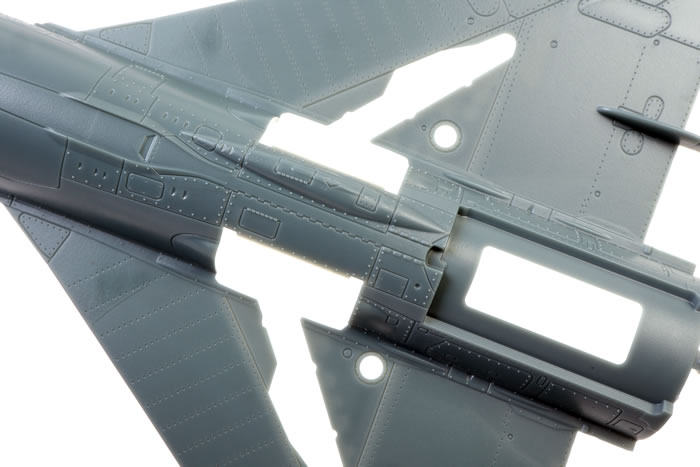
A very comprehensive 24 page A5 instruction manual explains in colour the construction of the kit in a number of stages, clearly delineating the differences for each of the four airframes catered for by the decals. Fifty parts are not used in this kit so the spares box will be boosted. Cockpit and undercarriage bay details are really nice and a great variety of weapons and tanks make up the possible stores. All colour details are clearly indicated in each step for Gunze and ModelMaster paints.
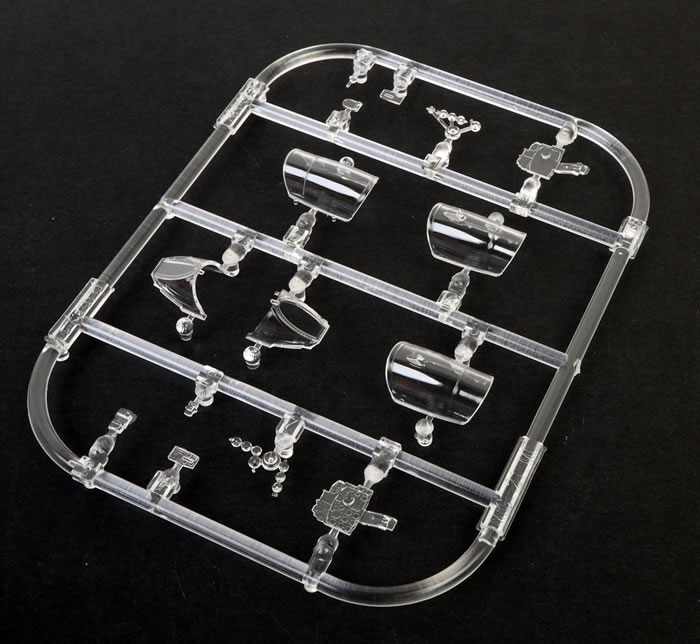
No nose weight is mentioned and judging by the undercarriage geometry MAY not be needed but I would still suggest a bit of mass on top of part D69, the forward front undercarriage bay roof just in front of the cockpit.
One page of the instructions shows the possible arrangement of tankage and armament - very useful!! And there is page to show the locations of the masks as well.
Instructions and Markings
A feature of this kit is the enormous sheet of stencils, and four pages of the instructions are devoted to the location of these on the airframe, pylons, tanks and weapons - that should keep the modeller occupied for a day, or two, or three in these isolation times! Note that the stencils are in two colours and their different usage is clearly stated for each decal choice.
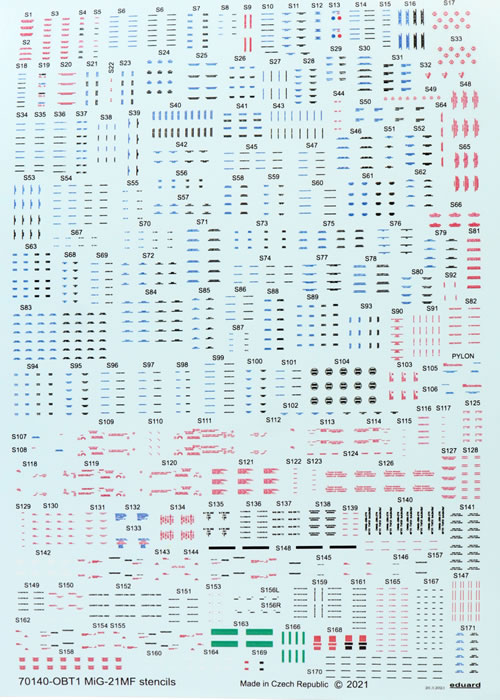
The four main decal options are as follows, each having a full-page colour set of drawings as well as a detailed explanation about the aircraft’s history and its crew and uses - a great idea.
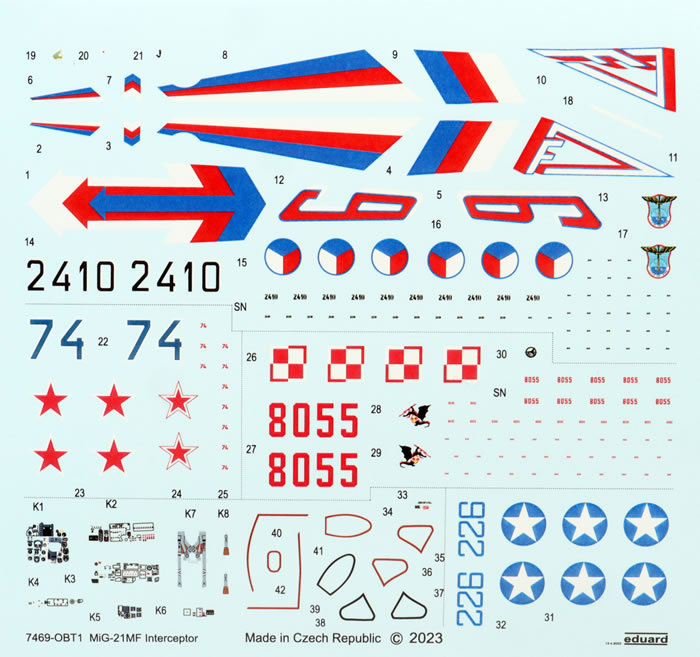
They are:
-
No. 96002430 of 1 Sqn, 9 Fighter Bomber Air Regiment, Czech Republic in September 1993 in overall natural metal with a decorative red/white/blue shape on the upper wings and colourful tail markings as well,
-
116CBP, of a training centre at Privolzhesky , Soviet Union, May 1990, in in a disruptive pattern of two greens, sand and brown over light blue,
-
8055 of the Polish AF in 1986-93 in bare metal overall, and
-
226, an interesting Somali A.F. one from Mogadishu Airport in 1991in sandy yellow over a pale blue with random green splotches.
Certainly a set of ‘different’ markings for those modellers interested in this important and widely-used Cold War aeroplane.
Recommend as always.
Thanks to Eduard for the sample

Review Text & Images Copyright © 2023 by Graham Carter
Images Copyright © 2023 by Brett Green
Page Created 11 July, 2023
Last updated
12 July, 2023
Back to HyperScale Main Page
Back to Reviews Page |
